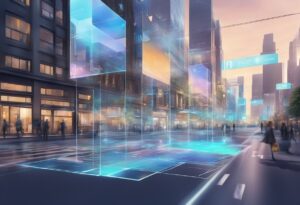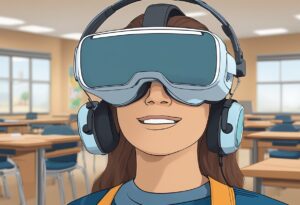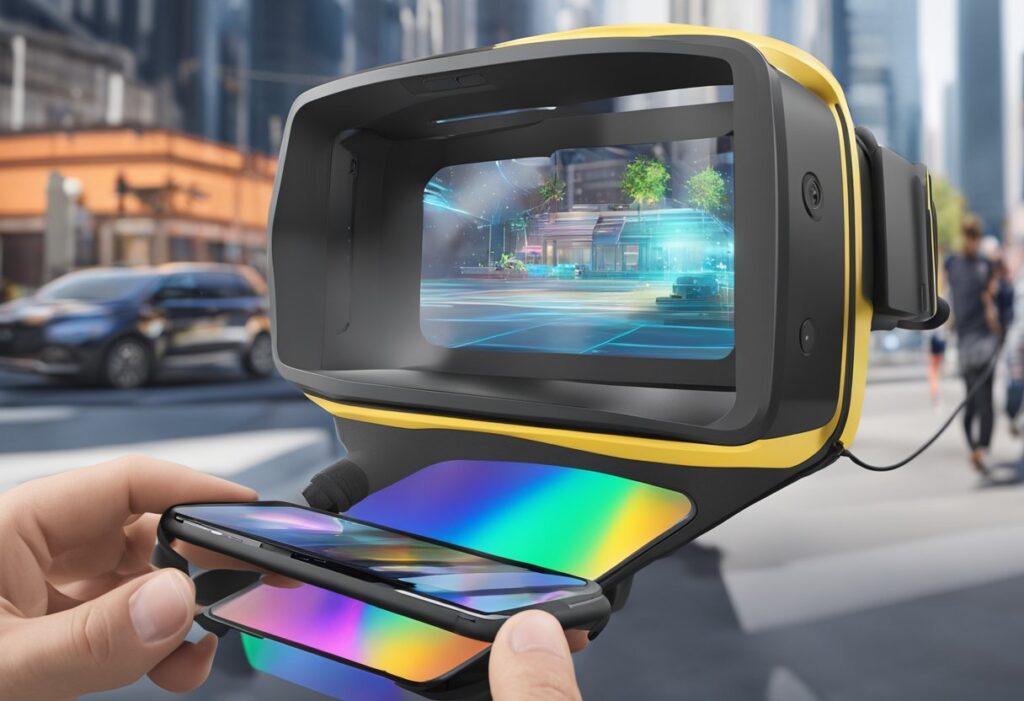Augmented reality (AR) is a technology that has revolutionized the way people interact with their environment. AR is a type of technology that overlays digital information onto the physical world. This technology has been used in various fields, including gaming, marketing, education, and manufacturing.
AR is a technology that enhances the user’s perception of the real world environment. It is different from virtual reality (VR), which creates a completely artificial environment. AR combines the real world with digital elements, allowing users to experience a new dimension of reality. The technology is used in various applications such as gaming, product visualization, and home design. With AR, users can interact with digital content in a more natural way, making it an exciting technology for the future.
Uses of Augmented Reality: Augmented reality has been used in various fields, including gaming, marketing, education, and manufacturing. In gaming, AR has been used to create immersive experiences that allow players to interact with digital objects in real-time. In marketing, AR has been used to create interactive product displays that allow consumers to visualize products in real-world settings. In education, AR has been used to create interactive learning experiences that allow students to visualize complex concepts in a more intuitive way. In manufacturing, AR has been used to create virtual prototypes, reducing the time and cost of product development.
Fundamentals of Augmented Reality
Defining AR and Its Core Technologies
Augmented Reality (AR) is a technology that enhances a user’s perception of the real world by overlaying computer-generated sensory information onto their view of the physical environment. AR technology uses a combination of hardware and software components, such as a display, camera, sensors, processor, and GPS, to create an interactive and immersive experience.
The core technologies used in AR include computer vision, image recognition, and tracking. Computer vision is the ability of a computer to interpret and understand visual information from the world around it. Image recognition is the ability of a computer to recognize and identify objects, patterns, and features in a visual image. Tracking is the ability of a computer to track the movement and position of an object or user in real-time.
AR technology has a wide range of applications, including gaming, entertainment, education, healthcare, and manufacturing.
AR vs. VR and Mixed Reality
AR technology is often compared to Virtual Reality (VR) and Mixed Reality (MR) technology. While AR enhances the user’s perception of the real world, VR technology creates a completely immersive and simulated environment. MR technology combines the real world with virtual objects to create a hybrid environment.
AR technology is more accessible and practical than VR and MR technology, as it does not require expensive hardware or specialized equipment. AR technology can be used with a smartphone or tablet, making it a more convenient and portable option.
AR technology is a rapidly evolving field that has the potential to revolutionize the way we interact with the world around us. With its core technologies and wide range of applications, AR technology is poised to become an essential tool in various industries.
AR Hardware and Devices

Augmented Reality (AR) technology has come a long way since its inception, and today, it is being used in various industries and applications. AR hardware and devices are essential components in the AR ecosystem, providing users with an immersive experience. In this section, we will discuss the different types of AR hardware and devices available in the market.
Smartphones and Tablets in AR
Smartphones and tablets are the most common devices used for AR applications. These devices come with built-in cameras, sensors, and processors that enable them to run AR apps.
AR apps use the device’s camera to track the user’s location and overlay digital content onto the real world. Smartphones and tablets are convenient for AR applications because they are portable and widely available.
Specialized AR Wearables
Specialized AR wearables are designed specifically for AR applications. These devices are worn on the body and provide users with a hands-free experience.
AR wearables include head-mounted displays (HMDs), eyeglasses, and HUDs. HMDs are the most common AR wearables and come in different forms, including diffractive waveguides and contact lenses. These devices provide users with an immersive experience by overlaying digital content onto the real world.
Evolution of AR Glasses and Headsets
AR glasses and headsets are becoming more popular as the technology evolves. These devices provide users with an immersive experience and are designed to be worn for extended periods. The first AR glasses were bulky and heavy, but today’s AR glasses are lightweight and stylish.
AR glasses and headsets use advanced sensors and processors to track the user’s location and overlay digital content onto the real world. As the technology evolves, AR glasses and headsets will become more common and affordable.
AR in Various Industries

Augmented Reality (AR) is a technology that is finding its way into various industries, from gaming and entertainment to healthcare and military. AR involves overlaying digital information onto the real world, creating an interactive and immersive experience. Here are some of the industries that have adopted AR technology to enhance their operations.
AR in Gaming and Entertainment
AR has revolutionized the gaming and entertainment industry by creating immersive and interactive experiences. Games like Pokemon Go and Ingress use AR to bring the game characters into the real world. AR has also been used in theme parks to enhance the visitor experience by overlaying digital information onto the real world.
Educational Applications of AR
AR is also being used in education to enhance the learning experience. AR enables students to visualize complex concepts and interact with them in a fun and engaging way. AR is being used in subjects like science, history, and geography to create interactive and immersive learning experiences.
Retail and Marketing Innovations
AR is being used in retail and marketing to create interactive and engaging experiences for customers. AR enables customers to try on clothes virtually and see how they look before making a purchase. AR is also being used in marketing to create interactive advertisements that engage customers and promote brand awareness.
Healthcare and Military Uses
AR is being used in healthcare to improve patient outcomes and enhance the training of medical professionals. AR enables medical professionals to visualize complex medical procedures and interact with them in a virtual environment. AR is also being used in the military to enhance training and improve situational awareness.
AR is a technology that is transforming various industries by creating immersive and interactive experiences. AR is being used in gaming, education, retail, healthcare, and military to enhance operations and improve outcomes. With the continuous innovations in AR technology, we can expect to see more industries adopting this technology in the future.
Software and Content Creation for AR

Augmented Reality (AR) is a rapidly developing technology that has found its way into various industries, including gaming, education, and healthcare. AR software and content creation tools have made it possible for developers to create interactive experiences that blend the physical and digital worlds.
Developing AR Apps and Games
AR app and game development require specialized software that allows developers to create interactive experiences. Some of the popular AR development software include Adobe Aero, Tvori, Vuforia Engine, and Unity 3D. These software provide developers with the tools to create 3D models, animations, and interactions that can be integrated into real-world environments.
Machine Learning and Object Recognition
AR technology relies on sensing and object recognition to create immersive experiences. Machine learning algorithms are used to train AR systems to recognize objects and environments.
This technology is used in various applications, including facial recognition, gesture recognition, and spatial mapping. Object recognition is also used in AR games, where players can interact with digital objects in the real world.
3D Modeling and Digital Information Integration
AR content creation involves 3D modeling and digital information integration. 3D models are created using specialized software such as Autodesk Maya, Blender, and SketchUp. These models can be integrated into AR experiences, allowing users to interact with digital objects in the real world.
Digital information integration involves the integration of text, images, and videos into AR experiences. This type of integration is commonly used in education and training applications, where users can access information about real-world objects and environments.
AR software and content creation tools have made it possible for developers to create immersive experiences that blend the physical and digital worlds. AR technology relies on sensing, object recognition, and 3D modeling to create interactive experiences.
Machine learning algorithms are used to train AR systems to recognize objects and environments. AR content creation involves 3D modeling and digital information integration, allowing users to interact with digital objects in the real world.
User Interaction and Experience in AR

Augmented Reality (AR) technology has revolutionized the way people interact with digital content. This section will explore some of the key ways in which AR enhances user interaction and experience.
Gesture and Voice Controls
AR technology enables users to interact with digital content in real-time using gesture and voice controls. This allows for a more natural and intuitive user experience, as users can interact with digital content in the same way they would interact with physical objects.
Gesture recognition technology uses input devices such as accelerometers and navigation sensors to detect movements and translate them into digital commands. Voice recognition technology allows users to control digital content using their voice, which can be particularly useful in situations where hands-free operation is required.
Enhancing Sensory Information
AR technology enhances sensory information by overlaying digital content onto the user’s real-world environment. This can include visual and audio cues, which can be used to provide additional information or guidance.
For example, AR technology can be used to provide real-time navigation instructions, which can be overlaid onto the user’s real-world environment. This can be particularly useful in situations where users are in unfamiliar environments or where traditional navigation methods are not available.
Real-Time Interaction with Digital World
AR technology enables users to interact with digital content in real-time, which can be particularly useful in situations where quick decision-making is required.
For example, AR technology can be used to provide real-time information about products in a retail environment, allowing users to make informed purchasing decisions. AR technology can also be used to provide real-time feedback on tasks such as assembly or repair, allowing users to make adjustments as they work.
AR technology has transformed the way people interact with digital content. By enabling natural and intuitive user interaction, enhancing sensory information, and providing real-time interaction with the digital world, AR technology has the potential to revolutionize a wide range of industries and applications.
Case Studies and Notable AR Implementations

Snapchat and Social Media Filters
Snapchat is one of the pioneers of AR technology in the social media industry. The company’s AR filters allow users to add virtual objects and animations to their photos and videos in real-time. Snapchat’s AR filters are widely popular among users, and they have been used in various marketing campaigns by brands. The filters have also been used in tourism campaigns to promote destinations.
IKEA Place and Retail Applications
IKEA Place is an AR app that allows users to virtually place furniture in their homes before purchasing it. The app uses ARKit, a framework developed by Apple for creating AR experiences on iOS devices.
IKEA Place is a great example of how AR technology can be used in the retail industry to enhance the customer experience. The app allows customers to see how furniture would look in their homes before making a purchase, reducing the likelihood of returns.
Pokemon Go and Location-Based Entertainment
Pokemon Go is an AR game that became a global phenomenon in 2016. The game uses location-based technology to allow players to catch virtual creatures in the real world. Pokemon Go is a great example of how AR technology can be used in the entertainment industry to create immersive experiences.
The game has been used by retailers to attract customers to their stores and by tourism boards to promote destinations.
AR technology has the potential to revolutionize various industries, including retail, entertainment, and tourism. As the technology continues to evolve, we can expect to see more innovative use cases of AR in the future.
Future of Augmented Reality
Trends in AR Technology
Augmented Reality (AR) technology is rapidly advancing, and the future looks promising. With the integration of Extended Reality (XR), AR is set to revolutionize various industries, including healthcare, education, and entertainment.
The use of computer vision and machine vision in AR technology has enabled the creation of more dynamic and interactive visual elements. The advancements in hardware components, such as cameras and sensors, have led to improved accuracy and dynamic range of AR applications.
Potential of AR in the Metaverse
The Metaverse is a virtual world where people can interact with each other and digital objects in real-time. AR has the potential to play a significant role in the Metaverse, enabling users to interact with virtual objects in the real world.
The integration of AR and the Metaverse can create a more immersive and interactive experience, blurring the lines between the virtual and physical worlds.
Advancements in Hardware and Software
The future of AR is dependent on advancements in both hardware and software. The development of lightweight and portable AR devices, such as smart glasses, will enable users to access AR content on the go. The integration of Artificial Intelligence (AI) and Machine Learning (ML) in AR software will enable more accurate and efficient tracking and recognition of objects in the real world.
The future of AR is bright, and with continued advancements in technology, it has the potential to transform the way we interact with the world around us.
What is an example of augmented reality
Uses of augmented reality
Augmented reality (AR) is a technology that overlays digital content onto the real world. AR has a wide range of uses, from entertainment to education, retail to healthcare.
One of the most well-known examples of AR is the mobile game Pokemon Go, which allows players to catch virtual creatures in the real world. Other examples include AR apps for interior design, allowing users to visualize furniture in their homes before making a purchase.
What is augmented reality and how does it work
AR works by using a camera and sensors to detect the real world, and then overlaying digital content onto it. This can be done through a mobile device or a headset. The digital content can be anything from simple graphics to complex 3D models. AR can also incorporate other sensory inputs, such as sound or touch.
How to create augmented reality
Creating AR requires specialized software and hardware. There are a variety of tools available, from simple drag-and-drop interfaces to more complex programming environments. Some popular AR development platforms include Unity, Vuforia, and ARKit. Creating AR content also requires knowledge of 3D modeling and animation.
Pros and cons of augmented reality
AR has many potential benefits, including enhancing user experiences, improving education and training, and increasing sales for retailers. However, there are also potential drawbacks, such as the cost and complexity of creating AR content, and concerns over privacy and security.
Augmented reality benefits
AR has a wide range of benefits, from improving customer engagement to enhancing learning experiences. AR can be used to create immersive and interactive experiences, allowing users to explore virtual environments and interact with digital content in new ways.
What do you need for augmented reality
To experience AR, users typically need a mobile device or a headset that is capable of running AR applications. Some AR experiences also require additional hardware, such as sensors or controllers.
First use of augmented reality
The first use of AR can be traced back to the 1960s, when Ivan Sutherland developed a head-mounted display that could overlay simple graphics onto the real world. However, it wasn’t until the 1990s that AR began to gain wider recognition and use.
What is the future for augmented reality
The future of AR is bright, with many experts predicting that AR will become an increasingly important part of our lives. AR has the potential to transform a wide range of industries, from healthcare to manufacturing, and to create new and innovative experiences for users.
As AR technology continues to evolve, we can expect to see even more exciting and innovative applications in the years to come.

Frequently Asked Questions
What are the core components that make up an augmented reality system?
An augmented reality system consists of three core components: hardware, software, and the user. The hardware includes devices such as smartphones, tablets, and smart glasses that are capable of displaying augmented reality content.
The software includes the applications and algorithms that enable the creation and display of augmented reality content. The user is an integral part of the system, as they interact with the augmented reality content through the hardware and software.
How does augmented reality technology integrate with human-computer interaction?
Augmented reality technology integrates with human-computer interaction by providing a more natural and intuitive way for users to interact with digital content.
Augmented reality allows users to interact with digital content in a way that feels more like interacting with physical objects in the real world. This is achieved through a combination of sensors, cameras, and computer vision algorithms that enable the system to understand the user’s environment and respond accordingly.
Can you provide examples of applications that utilize augmented reality?
Augmented reality has a wide range of applications across various industries. Some examples include:
- Retail: allowing customers to try on clothes or visualize furniture in their home before purchasing
- Education: providing interactive and immersive learning experiences for students
- Healthcare: assisting doctors and surgeons in medical procedures
- Entertainment: enhancing live events and performances with augmented reality effects
What distinguishes augmented reality from virtual reality?
The main difference between augmented reality and virtual reality is that augmented reality overlays digital content onto the real world, while virtual reality creates a completely virtual environment.
Augmented reality enhances the user’s perception of the real world, while virtual reality creates a new, immersive environment for the user to explore.
What are the different methods used to create augmented reality experiences?
There are several methods used to create augmented reality experiences, including marker-based, markerless, and projection-based methods.
Marker-based augmented reality uses a physical marker, such as a QR code or image, to trigger the display of augmented reality content.
Markerless augmented reality uses computer vision algorithms to detect and track objects in the real world. Projection-based augmented reality projects digital content onto physical objects in the real world.
How is augmented reality expected to impact various industries in the future?
Augmented reality is expected to have a significant impact on various industries in the future. It has the potential to revolutionize the way we work, learn, and interact with the world around us. In retail, it will provide customers with a more personalized and immersive shopping experience.
In healthcare, it will assist doctors and surgeons in performing complex procedures. In education, it will provide students with interactive and engaging learning experiences. Overall, the future of augmented reality is bright, and we can expect to see many exciting developments in the years to come.














